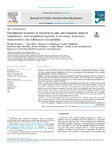2021-12-25Zeitschriftenartikel
Glycopeptide resistance in Enterococcus spp. and coagulase-negative staphylococci from hospitalised patients in Germany: occurrence, characteristics and dalbavancin susceptibility
Kresken, Michael
Klare, Ingo
Wichelhaus, Thomas A.
Wohlfarth, Esther
Layer-Nicolaou, Franziska
Neumann, Bernd
Werner, Guido
Study Group ‘Antimicrobial Resistance’ of the Paul-Ehrlich-Society for Chemotherapy
Objectives:
The aim of this study was to evaluate the occurrence of glycopeptide resistance in enterococci and coagulase-negative staphylococci (CoNS) and to determine the susceptibilities of the identified glycopeptide-resistant isolates to dalbavancin.
Methods:
Twenty-two medical laboratories participated in the study conducted in 2016/17 by the Paul-Ehrlich-Society for Chemotherapy. Each laboratory was asked to collect 30 Enterococcus spp. (limited to Enterococcus faecalis and Enterococcus faecium) and 30 CoNS isolates consecutively from hospitalised patients with a proven or suspected infection.
Results:
A total of 1285 isolates were collected, comprising 364 E. faecalis, 291 E. faecium and 630 CoNS. No E. faecalis isolates (0%) but 76 E. faecium isolates (26.1%) were vancomycin-resistant, of which 21 showed the VanA type and 55 the VanB type. The proportion of vancomycin-resistant strains among E. faecium isolates from patients in intensive care units (21.6%) was significantly lower than that from patients on regular wards (30.5%). Among the CoNS, 67 isolates (10.6%) were teicoplanin-resistant but none were vancomycin-resistant, with resistance only detected in Staphylococcus epidermidis (12.2%), Staphylococcus haemolyticus (17.9%) and Staphylococcus hominis (13.2%). Dalbavancin at ≤0.25 mg/L inhibited all VanB-type enterococci and 95.5% of teicoplanin-resistant CoNS.
Conclusion:
The level of glycopeptide resistance in E. faecalis remains very low in Germany but achieved 26% in E. faecium and was >10% in CoNS. Dalbavancin appears to be a feasible option for treating infections caused by VanB-type vancomycin-resistant E. faecium and teicoplanin-resistant CoNS.
Dateien zu dieser Publikation

